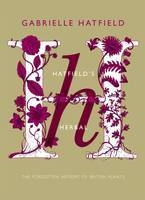
Hatfield's Herbal
The Curious Stories of Britain's Wild Plants
Seiten
2007
Penguin Books Ltd (Verlag)
978-0-14-051577-0 (ISBN)
Penguin Books Ltd (Verlag)
978-0-14-051577-0 (ISBN)
- Titel ist leider vergriffen;
keine Neuauflage - Artikel merken
Outlining the history and uses of over 150 British plants, this book offers a history of what life was once like. It is an illustrated guide to the native plants of Britain.
From ivy wreathed buildings to the dandelions growing through the cracks between paving stones, we are surrounded by a wealth of native plants. In the past they were a hugely valued resource: magical, mystical and medical. Puppies were once fed daisy flowers in milk to keep them small, while children wore daisy chains to protect against fairy kidnapping. Poachers scattered mullein seed on the surface of the water to drug fish. Chewing bramble leaves alleviates toothache. Until the nineteenth century the bodies of paupers and suicides were left on trestles in churchyards between death and burial, scattered with feverfew to delay their decay.In the flu epidemic of 1918 many Irish people carried wild garlic in their pockets to avoid infection. Packed with stories and memorable information, this book is the highly personal, very readable result of a lifetime spent researching folk cures and the science behind them.
Outlining the history and uses of over 150 British plants, "Hatfield's Herbal" offers a fascinating history of what life was once like, a beautifully illustrated, evocative guide to our native plants and a passionate argument why we should better appreciate the riches we already have.
From ivy wreathed buildings to the dandelions growing through the cracks between paving stones, we are surrounded by a wealth of native plants. In the past they were a hugely valued resource: magical, mystical and medical. Puppies were once fed daisy flowers in milk to keep them small, while children wore daisy chains to protect against fairy kidnapping. Poachers scattered mullein seed on the surface of the water to drug fish. Chewing bramble leaves alleviates toothache. Until the nineteenth century the bodies of paupers and suicides were left on trestles in churchyards between death and burial, scattered with feverfew to delay their decay.In the flu epidemic of 1918 many Irish people carried wild garlic in their pockets to avoid infection. Packed with stories and memorable information, this book is the highly personal, very readable result of a lifetime spent researching folk cures and the science behind them.
Outlining the history and uses of over 150 British plants, "Hatfield's Herbal" offers a fascinating history of what life was once like, a beautifully illustrated, evocative guide to our native plants and a passionate argument why we should better appreciate the riches we already have.
Gabrielle Hatfield is a distinguished historian of plant medicine. She studied botany at Cambridge, then a PhD at Edinburgh in plant medicine. The winner of two literary prizes (Michaelis-Jean Ratcliff Prize and the John Thackray Medal), she is currently a research associate at Kew, and a member of the council of management of Ethnomedica. Married to a GP, she has four children, several sheep, a herd of geese, a Shetland pony and a peacock, all of whom have benefited from her herbal remedies. She lives in Norfolk.
| Erscheint lt. Verlag | 1.11.2007 |
|---|---|
| Zusatzinfo | 100 illustrations |
| Verlagsort | London |
| Sprache | englisch |
| Maße | 162 x 221 mm |
| Gewicht | 760 g |
| Themenwelt | Sachbuch/Ratgeber ► Gesundheit / Leben / Psychologie ► Alternative Heilverfahren |
| Medizin / Pharmazie ► Naturheilkunde ► Phytotherapie | |
| ISBN-10 | 0-14-051577-1 / 0140515771 |
| ISBN-13 | 978-0-14-051577-0 / 9780140515770 |
| Zustand | Neuware |
| Haben Sie eine Frage zum Produkt? |
Mehr entdecken
aus dem Bereich
aus dem Bereich
Buch | Softcover (2023)
Urban & Fischer in Elsevier (Verlag)
CHF 44,75


